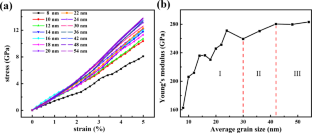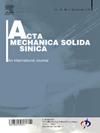Multi-field Coupled Inverse Hall–Petch Relations for Ferroelectric Nanocrystals
Abstract
Tailoring grain size can improve the strength of polycrystals by regulating the proportion of grains to grain boundaries and the interaction area. As the grain size decreases to the nanoscale, the deformation mechanism in polycrystals shifts from being primarily mediated by dislocations to deformation occurring within the grains and grain boundaries. However, the mechanism responsible for fine-grain strengthening in ferroelectric materials remains unclear, primarily due to the complex multi-field coupling effect arising from spontaneous polarization. Through molecular dynamics simulations, we investigate the strengthening mechanism of barium titanate (BaTiO3), with extremely fine-grain sizes. This material exhibits an inverse Hall–Petch relationship between grain size and strength, rooting in the inhomogeneous concentration of atomic strain and grain rotation. Furthermore, we present a theoretical model to predict the transition from the inverse Hall–Petch stage to the Hall–Petch stage based on strength variations with size, which aligns well with the simulation results. It has been found that the piezoelectric properties of the BaTiO3 are affected by polarization domain switching at various grain sizes. This study enhances our understanding of the atomic-scale mechanisms that contribute to the performance evolution of fine-grain nano-ferroelectric materials. It also provides valuable insights into the design of extremely small-scale ferroelectric components.


 求助内容:
求助内容: 应助结果提醒方式:
应助结果提醒方式:


